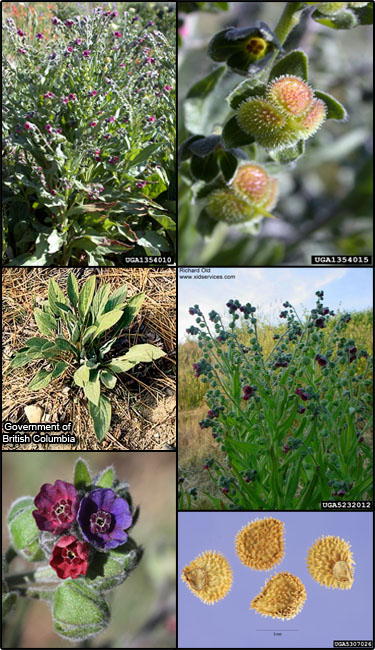Houndstongue (Cynoglossum officinale)
 Common Names: Gypsyflower
Common Names: GypsyflowerDescription: Plant is highly toxic, it contains alkaloids that may cause liver cells to stop reproducing.
Habit: Biennial; 20-122 cm (8-48 in) tall; 1st year growth is vegetative, 2nd year is flowering.
Leaves: 1st year - petiolate, elliptical, dark green, 6-8 in (15-20 cm) long; 2nd year - Alternate, sessile or clasping, narrow towards top of plant.
Stems: Erect; 30-120 cm tall.
Flowers: Appear on racemes from the axils of upper leaves, reddish-purple in color, 5 lobed corolla.
Fruit and seeds: Indehiscent, divided into 1-4 nutlets that are 5-7mm long, flattened along the top and covered with small hooked burrs or spines.
Habitat: Native to Eurasia. Found in riparian zones, coastlands, grasslands and agricultural areas.
Reproduction: By seed.
Similar species: Native Velvetweed (Gaura parviflora).
Monitoring and rapid response: Mowing second year plants during flowering but before seed maturation; effectively controlled using any of the several readily available general use herbicides such as Picloram, 2,4-D, metsulfuron or dicamba. Credits: The information provided in this factsheet was gathered from the Invasive Plant Atlas, the ISSG Global Invasive Species Database and the USDA PLANTS Database.
Individual species images that appear with a number in a black box are courtesy of the Bugwood.org network (http://www.invasive.org).Individual photo author credits may not be included due to the small display size of the images and subsequent difficulty of reading the provided text. All other images appear courtesy of Google (http://images.google.com).
Common Name: | Houndstongue |
Scientific Name: | Cynoglossum officinale |
Family: | Boraginaceae (Borage) |
Duration: | Biennial |
Habit: | Herbs |
USDA Symbol: | CYOF |
